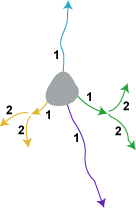Each tree (branched structure)

Breaks down the results for each tree by centrifugal branch order. All segments of a given branch order for a given tree are grouped together.
Example: if a specific tree (a dendrite or axon) has 3 segments that are third-order branches, these 3 segments will be totaled and averaged in the results. See Branch Order Characteristics for details about the various types of branch order classifications.
- Use the Options>General Preferences>Orderings tab to select different branch ordering methods.
Analysis results
Total length for all branches in the tree with the same branch order.
- Mean = [Length] / [Number of branches]
- Variance: Set to 0 if there is only 1 branch. Otherwise computed for the set of branches.
Computed by modeling each branch as a frustum (truncated right circular cone).
- Mean = [Surface] / [Number of branches]
- Variance: Set to 0 if there is only 1 branch. Otherwise computed for the set of branches.
Computed by modeling each branch as a frustum (truncated right circular cone).
- Mean = [Volume] / [Number of branches]
- Variance: Set to 0 if there is only 1 branch. Otherwise computed for the set of branches.
The nodes are computed according to the number of segments of that order ending in nodes and the degree of the node.
A node is assigned to the segment leading to the node.
Degrees (0, 1, 2, >2):
- Termination: degree 0.
- Bifurcation: degree 2.
- Nodes of degree higher than 2 are grouped under >2.
The numbers of endings are counted according to their type (i.e., normal, high, low, incomplete, origin, midpoint, and generated).
The types were selected while tracing.
| Normal Ending (N) | Default |
| High Ending (H) |
Ending located at the top of the current section. Depending on the orientation of the sections, the process may continue into another section.
|
| Low Ending (L) | Ending located at the bottom of the current section. |
| Incomplete (I) | Use to label arbitrary endings, endings that disappear for unknown reasons, endings that should be audited later.. |
| Origin Ending (O) |
Indicates the directionality of the tree.
Neurolucida Explorer keeps track of directionality to apply branch orders. |
| Midpoint (M) | Ending of a long branch that is indeterminate at the time it is placed. |
Also see Individual Tree analysis.
